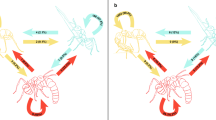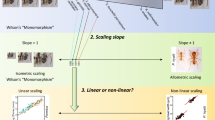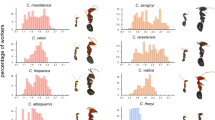Abstract
A main challenge in the analysis of division of labor in insect societies characterized by worker polymorphism has been identifying the number of physical castes and determining their relationship to task performance. We addressed this question using the extremely polymorphic leafcutter ant Atta cephalotes as a model by measuring 22 morphological characters and applying multivariate Gaussian mixture modeling to define worker size-class boundaries. Our statistical approach discriminated five physical worker size classes (subcastes) and found continuous variation in most morphological characters. Some worker size classes showed patterns of covariance, modularity, and integration in head, mandible, and leg traits, suggesting biomechanical functionality in tasks such as leaf cutting. Task repertoires and act frequencies were recorded to identify how fungal gardening, brood care, leaf-harvesting, and other tasks were distributed across worker size groups. Results showed that small and mid-sized media workers performed more diverse and complex tasks, including leaf harvesting, than workers of other size classes. Minims participated in fungal-gardening and nursing tasks, whereas large medias mainly participated in leafcutting and majors made few direct contributions to fungal cultivation. Results of our integrative analyses demonstrate the existence of an unexpectedly large number of worker size classes that can differ significantly in performance of agricultural tasks. However, overlap in task repertoires of workers at size-class boundaries suggests that not all morphologically distinct groups display discrete behavioral profiles. Morphological groups are instead distinguished by a combination of the tasks that each performs and their relative frequencies.
Significance statement
The evolutionary coupling of behavior and morphology is central to understanding division of labor in insect societies. Our work applies robust statistical modelling to offer a novel analysis of worker physical caste categorization based on extensive morphometric sampling. Our method improves upon previous approaches by incorporating measurements of a large number of diverse morphological traits likely involved in task performance to examine worker physical caste evolution. We integrate morphological evolution with behavioral data on relative task performance rates and task repertoire size to describe the morphological and behavioral space of size-variable workers. Our approach provides methods to quantitatively analyze division of labor and behavioral performance, and offers new insights into worker trait modularity and integration and task performance associated with the organization of complex insect societies.





Similar content being viewed by others
Data availability
All behavior and morphology data are available in supplementary tables.
Code availability
Code used for analysis is available at: https://github.com/Imuratore-bio/ant-morphology-behavior.
References
Abouheif E (2021) Ant caste evo-devo: it’s not all about size. Trends Ecol Evol 36:668–670. https://doi.org/10.1016/j.tree.2021.04.002
Anderson PSL, Rivera MD, Suarez AV (2020) “Simple” biomechanical model for ants reveals how correlated evolution among body segments minimizes variation in center of mass as heads get larger. Integr Comp Biol 60:1193–1207. https://doi.org/10.1093/icb/icaa027
Arenas A, Roces F (2016) Gardeners and midden workers in leaf-cutting ants learn to avoid plants unsuitable for the fungus at their worksites. Anim Behav 115:167–174. https://doi.org/10.1016/j.anbehav.2016.03.016
Arenas A, Roces F (2017) Avoidance of plants unsuitable for the symbiotic fungus in leaf-cutting ants: learning can take place entirely at the colony dump. PLoS ONE 12:e0171388. https://doi.org/10.1371/journal.pone.0171388
Arganda S, Hoadley AP, Razdan ES, Muratore IB, Traniello JFA (2020) The neuroplasticity of division of labor: worker polymorphism, compound eye structure and brain organization in the leafcutter ant Atta cephalotes. J Comp Physiol A 206:651–662. https://doi.org/10.1007/s00359-020-01423-9
Arthur D, Vassilvitskii S (2006) K-means++: the advantages of careful seeding, https://theory.stanford.edu/~sergei/papers/kMeansPP-soda.pdf
Bertossa RC (2011) Morphology and behaviour: functional links in development and evolution. Phil Trans R Soc B 366:2056–2068. https://doi.org/10.1098/rstb.2011.0035
Bourke AFG, Franks NR (2019) Social evolution in ants. Princeton University Press, Princeton
Burd M (2000) Body size effects on locomotion and load carriage in the highly polymorphic leaf-cutting ants Atta colombica and Atta cephalotes. Behav Ecol 11:125–131. https://doi.org/10.1093/beheco/11.2.125
Casadei-Ferreira A, Friedman NR, Economo EP, Pie MR, Feitosa RM (2021) Head and mandible shapes are highly integrated yet represent two distinct modules within and among worker subcastes of the ant genus Pheidole. Ecol Evol 11:6104–6118. https://doi.org/10.1002/ece3.7422
Cherrett JM (1972) Some factors involved in the selection of vegetable substrate by Atta cephalotes (L.) (Hymenoptera: Formicidae) in tropical rain forest. J Anim Ecol 41:647–660. https://doi.org/10.2307/3200
Diniz-Filho JAF, Von Zuben CJ, Fowler HG, Schlindwein MN, Bueno OC (1994) Multivariate morphometrics and allometry in a polymorphic ant. Insect Soc 41:153–163. https://doi.org/10.1007/BF01240475
Dupuis EC, Harrison JF (2017) Trunk trail maintenance in leafcutter ants: caste involvement and effects of obstacle type and size on path clearing in Atta cephalotes. Insect Soc 64:189–196. https://doi.org/10.1007/s00040-016-0530-y
Evison SEF, Hart AG, Jackson DE (2008) Minor workers have a major role in the maintenance of leafcutter ant pheromone trails. Anim Behav 75:963–969. https://doi.org/10.1016/j.anbehav.2007.07.013
Feener D, Lighton J, Bartholomew G (1988) Curvilinear allometry, energetics and foraging ecology: a comparison of leaf-cutting ants and army ants. Funct Ecol 2:509–520
Fernandez-Marin H, Zimmermann J, Wcislo W (2003) Nest-founding in Acromyrmex octospinosus (Hymenoptera, Formicidae, Attini): demography and putative prophylactic behaviors. Insectes Soc 50:304–308. https://doi.org/10.1007/s00040-003-0687-z
Friedman NR, Bennet BL, Fischer G, Sarnat EM, Huang J-P, Knowles Knowles LL, Economo EP (2020) Macroevolutionary integration of phenotypes within and across ant worker castes. Ecol Evol 10:9371–9383. https://doi.org/10.1002/ece3.6623
Garrett RW, Carlson KA, Goggans MS, Nesson MH, Shepard CA, Schofield RMS (2016) Leaf processing behaviour in Atta leafcutter ants: 90% of leaf cutting takes place inside the nest, and ants select pieces that require less cutting. R Soc Open Sci 3:150111. https://doi.org/10.1098/rsos.150111
Gordon DG, Ilieş I, Traniello JFA (2017) Behavior, brain, and morphology in a complex insect society: trait integration and social evolution in the exceptionally polymorphic ant Pheidole rhea. Behav Ecol Sociobiol 71:166. https://doi.org/10.1007/s00265-017-2396-z
Gronenberg W, Paul J, Just S, Hölldobler B (1997) Mandible muscle fibers in ants: fast or powerful? Cell Tissue Res 289:347–361. https://doi.org/10.1007/s004410050882
Grüter C, Menezes C, Imperatriz-Fonseca VL, Ratnieks FLW (2012) A morphologically specialized soldier caste improves colony defense in a neotropical eusocial bee. P Natl Acad Sci USA 109:1182–1186. https://doi.org/10.1073/pnas.1113398109
Hart AG, Ratnieks FLW (2001) Task partitioning, division of labour and nest compartmentalisation collectively isolate hazardous waste in the leafcutting ant Atta cephalotes. Behav Ecol Sociobiol 49:387–392. https://doi.org/10.1007/s002650000312
Hölldobler B, Wilson EO (2010) The leafcutter ants: civilization by instinct. W. W. Norton & Company, New York
Honorio R, Doums C, Molet M (2020) Manipulation of worker size diversity does not affect colony fitness under natural conditions in the ant Temnothorax nylanderi. Behav Ecol Sociobiol 74:104. https://doi.org/10.1007/s00265-020-02885-2
Ilieş I, Muscedere ML, Traniello JFA (2015) Neuroanatomical and morphological trait clusters in the ant genus Pheidole: evidence for modularity and integration in brain structure. Brain Behav Evol 85:63–76. https://doi.org/10.1159/000370100
Josens R, Lopez MA, Jofré N, Giurfa M (2018) Individual size as determinant of sugar responsiveness in ants. Behav Ecol Sociobiol 72:162. https://doi.org/10.1007/s00265-018-2581-8
Kaiser HF (1958) The varimax criterion for analytic rotation in factor analysis. Psychometrika 23:187–200. https://doi.org/10.1007/BF02289233
Kamhi JF, Ilieş I, Traniello JFA (2019) Social complexity and brain evolution: comparative analysis of modularity and integration in ant brain organization. Brain Behav Evol 93:4–18. https://doi.org/10.1159/000497267
Kamhi JF, Sandridge‐Gresko A, Walker C, Robson SK, Traniello JF (2017) Worker brain development and colony organization in ants: does division of labor influence neuroplasticity?. Dev Neurobiol 77:1072–1085. https://doi.org/10.1002/dneu.22496
Magwene PM (2001) New tools for studying integration and modularity. Evolution 55:1734–1745
McLachlan GJ, Peel D (2000) Finite Mixture Models. Wiley, New York
Mehdiabadi N, Schultz T (2010) Natural history and phylogeny of the fungus-farming ants (Hymenoptera: Formicidae: Myrmicinae: Attini). Myrmecol News 13:37–55
Menzel U (2021) EMT, version 1.2, http://bioconductor.statistik.tu-dortmund.de/cran/web/packages/EMT/EMT.pdf
Mertl AL, Traniello JFA (2009) Behavioral evolution in the major worker subcaste of twig-nesting Pheidole (Hymenoptera: Formicidae): does morphological specialization influence task plasticity? Behav Ecol Sociobiol 63:1411–1426. https://doi.org/10.1007/s00265-009-0797-3
Molet M, Wheeler DE, Peeters C (2012) Evolution of novel mosaic castes in ants: modularity, phenotypic plasticity, and colonial buffering. Am Nat 180:328–341. https://doi.org/10.1086/667368
Mueller UG (2002) Ant versus fungus versus mutualism: ant-cultivar conflict and the deconstruction of the attine ant-fungus symbiosis. Am Nat 160:S67–S98. https://doi.org/10.1086/342084
Muratore IB, Fandozzi EM, Traniello JFA (2022) Behavioral performance and division of labor influence brain mosaicism in the leafcutter ant Atta cephalotes. J Comp Physiol A 208:325–344. https://doi.org/10.1007/s00359-021-01539-6
Muratore IB, Mullen SP, Traniello JFA (2023) Transcriptomic analysis of mosaic brain differentiation underlying complex division of labor in a social insect. J Comp Neurol 531:853–865. https://doi.org/10.1002/cne.25469
Muratore IB, Traniello JFA (2020) Fungus-growing ants: models for the integrative analysis of cognition and brain evolution. Front Behav Neurosci 14:599234. https://doi.org/10.3389/fnbeh.2020.599234
Muscedere ML, Traniello JFA (2012) Division of labor in the hyperdiverse ant genus Pheidole is associated with distinct subcaste- and age-related patterns of worker brain organization. PLoS ONE 7:e31618. https://doi.org/10.1371/journal.pone.0031618
Nichols-Orians CM, Schultz JC (1989) Leaf toughness affects leaf harvesting by the leaf cutter ant, Atta cephalotes (L.) (Hymenoptera: Formicidae). Biotropica 21:80–83. https://doi.org/10.2307/2388446
Oksanen J, Blanchet FG, Friendly M et al (2020) Package ‘vegan’. Commun Ecology Package Version 2:1–295 https://cran.r-project.org/web/packages/vegan/index.html
Oster GF, Wilson EO (1978) Caste and ecology in the social insects. Princeton University Press, Princeton
Paul J, Gronenberg W (1999) Optimizing force and velocity: mandible muscle fibre attachments in ants. J Exp Biol 202:797–808
Peet RK (1975) Relative diversity indices. Ecology 56:496–498
Pie MR, Traniello JFA (2007) Morphological evolution in a hyperdiverse clade: the ant genus Pheidole. J Zool 271:99–109. https://doi.org/10.1111/j.1469-7998.2006.00239.x
Pie MR, Tschá MK (2013) Size and shape in the evolution of ant worker morphology. PeerJ 1:e205. https://doi.org/10.7717/peerj.205
Powell S (2011) How much do army ants eat? On the prey intake of a neotropical top-predator. Insect Soc 58:317–324. https://doi.org/10.1007/s00040-011-0152-3
Powell S, Clark E (2004) Combat between large derived societies: a subterranean army ant established as a predator of mature leaf-cutting ant colonies. Insect Soc 51:342–351. https://doi.org/10.1007/s00040-004-0752-2
Powell S, Price SL, Kronauer DJC (2020) Trait evolution is reversible, repeatable, and decoupled in the soldier caste of turtle ants. P Natl Acad Sci USA 117:6608–6615. https://doi.org/10.1073/pnas.1913750117
Püffel F, Pouget A, Liu X, Zuber M, van de Kamp T, Roces F, Labonte D (2021) Morphological determinants of bite force capacity in insects: a biomechanical analysis of polymorphous leaf-cutter ants. J R Soc Interface 18:20210424
Riveros AJ, Seid MA, Wcislo WT (2012) Evolution of brain size in class-based societies of fungus-growing ants (Attini). Anim Behav 83:1043–1049. https://doi.org/10.1016/j.anbehav.2012.01.032
Riveros Rivera AJ, Gronenberg W (2009) Social brains and behavior: past and present. In: Gadau J, Fewell J (eds) Organization of Insect Societies - From Genome to Sociocomplexity. Harvard University, Cambridge, pp 377–401
Roberts SJ, Husmeier D, Rezek I, Penny W (1998) Bayesian approaches to gaussian mixture modeling. IEEE Trans Pattern Anal Mach Intell 20:1133–1142. https://doi.org/10.1109/34.730550
Robson SKA, Traniello JFA (2016) Division of labor in complex societies: a new age of conceptual expansion and integrative analysis. Behav Ecol Sociobiol 70:995–998. https://doi.org/10.1007/s00265-016-2147-6
Roces F, Hölldobler B (1994) Leaf density and a trade-off between load-size selection and recruitment behavior in the ant Atta cephalotes. Oecologia 97:1–8. https://doi.org/10.1007/BF00317902
Sánchez-Peña SR, Mueller UG (2002) A nocturnal raid of Nomamyrmex army ants on Atta leaf-cutting ants (Hymenoptera: Formicidae) in Tamaulipas, Mexico. Southwest Entomol 27:221–223
Saverschek N, Herz H, Wagner M, Roces F (2010) Avoiding plants unsuitable for the symbiotic fungus: learning and long-term memory in leaf-cutting ants. Anim Behav 79:689–698. https://doi.org/10.1016/j.anbehav.2009.12.021
Saverschek N, Roces F (2011) Foraging leafcutter ants: olfactory memory underlies delayed avoidance of plants unsuitable for the symbiotic fungus. Anim Behav 82:453–458. https://doi.org/10.1016/j.anbehav.2011.05.015
Schwarz G (1978) Estimating the dimension of a model. Ann Stat 6:461–464
Seeley TD (1982) Adaptive significance of the age polyethism schedule in honeybee colonies. Behav Ecol Sociobiol 11:287–293. https://doi.org/10.1007/BF00299306
Segre PS, Taylor ED (2019) Large ants do not carry their fair share: maximal load-carrying performance of leaf-cutter ants (Atta cephalotes). J Exp Biol 222:jeb199240. https://doi.org/10.1242/jeb.199240
Swartz MB (1998) Predation on an Atta cephalotes colony by an army ant Nomamyrmex esenbecki. Biotropica 30:682–684
Thiele T, Kost C, Roces F, Wirth R (2014) Foraging leaf-cutting ants learn to reject Vitis vinifera ssp. vinifera plants that emit herbivore-induced volatiles. J Chem Ecol 40:617–620. https://doi.org/10.1007/s10886-014-0460-y
Travaglini R, Forti L, Camargo R (2015) Foraging behavior of leaf cutting ants: how do workers search for their food? Sociobiology 62:347–350. https://doi.org/10.13102/sociobiology.v62i3.714
Trible W, Kronauer DJC (2017) Caste development and evolution in ants: it’s all about size. J Exp Biol 220:53–62. https://doi.org/10.1242/jeb.145292
Trible W, Kronauer DJC (2021) Ant caste evo-devo: size predicts caste (almost) perfectly. Trends Ecol Evol 37:671–673. https://doi.org/10.1016/j.tree.2021.05.004
Vavrek MJ (2011) Fossil: Palaeoecological and palaeogeographical analysis tools. Palaeontol Electron 14:16
Waddington SJ, Hughes WOH (2010) Waste management in the leaf-cutting ant Acromyrmex echinatior: the role of worker size, age and plasticity. Behav Ecol Sociobiol 64:1219–1228. https://doi.org/10.1007/s00265-010-0936-x
Wagner T, Bachenberg L, Glaser SM, Oikonomou A, Linn M, Grüter C (2020) Large body size variation is associated with low communication success in tandem running ants. Behav Ecol Sociobiol 75:4. https://doi.org/10.1007/s00265-020-02941-x
Weber JN, Peterson BK, Hoekstra HE (2013) Discrete genetic modules are responsible for complex burrow evolution in Peromyscus mice. Nature 493:402–405. https://doi.org/10.1038/nature11816
West M, Purcell J (2020) Task partitioning in ants lacking discrete morphological worker subcastes. Behav Ecol Sociobiol 74:66. https://doi.org/10.1007/s00265-020-02845-w
Wetterer JK (1991) Allometry and the geometry of leaf-cutting in Atta cephalotes. Behav Ecol Sociobiol 29:347–351. https://doi.org/10.1007/BF00165959
Wetterer JK (1999) The ecology and evolution of worker size-distribution in leaf-cutting ants (Hymenoptera: Formicidae). Sociobiology 34:119–144
Wickham H, Chang W (2015) ggplot2, https://cran.r-project.org/web/packages/ggplot2/index.html
Wills BD, Powell S, Rivera MD, Suarez AV (2018) Correlates and consequences of worker polymorphism in ants. Annu Rev Entomol 63:575–598. https://doi.org/10.1146/annurev-ento-020117-043357
Wilson EO (1953) The origin and evolution of polymorphism in ants. Q Rev Biol 28:136–156. https://doi.org/10.1086/399512
Wilson EO (1980a) Caste and division of labor in leaf-cutter ants (Hymenoptera, Formicidae, Atta). I. The overall pattern in Atta sexdens. Behav Ecol Sociobiol 7:143–156. https://doi.org/10.1007/BF00299520
Wilson EO (1980b) Caste and division of labor in leaf-cutter ants (Hymenoptera: Formicidae: Atta). II. The ergonomic optimization of leaf cutting. Behav Ecol Sociobiol 7:157–165. https://doi.org/10.1007/bf00299521
Wilson EO (1983) Caste and division of labor in leaf-cutter ants (Hymenoptera: Formicidae: Atta). III. Ergonomic resiliency in foraging by A. cephalotes. Behav Ecol Sociobiol 14:47–54
Wilson EO (1968) The ergonomics of caste in the social insects. Am Nat 102:41–66
Wolda H (1981) Similarity indices, sample size and diversity. Oecologia 50:296–302
Acknowledgements
We thank Associate Editor William Hughes and two anonymous reviewers for their helpful recommendations for our manuscript. We gratefully acknowledge the help of Dr. Sean Mullen (feedback on manuscript and study design), Dr. Ehab Abouheif (worker size distribution data sharing), Dr. Waring Trible (data discussion), Eli Levitt (Fig. organization), Zach Coto (animal husbandry and data discussion), and Frank Azorsa (field collection, animal husbandry, and data discussion). We are grateful to Dr. Christopher Starr and Ricardo Pillai for assistance with field work in Trinidad and to Andrew Hoadley for colony collection. Live colonies were collected in Trinidad in compliance with the laws of Trinidad and Tobago and imported to the USA in compliance with the conditions of USDA APHIS Permit P526P-12-04067.
Funding
This study was funded by the National Science Foundation grants IOS 1354291 and IOS 1953393 to JFAT, an award from the Undergraduate Research Opportunities Program at Boston University to FHZ, and the Department of Biology Brenton R. Lutz Award and the Belamarich Dissertation Writing Award to IBM.
Author information
Authors and Affiliations
Contributions
IBM, JFAT, and II designed the study. IBM drafted the manuscript. IBM, JFAT, and II developed the manuscript. IBM, JFAT, and II edited the manuscript. AKH and IBM collected morphometric data. IBM collated and processed raw measurement data. II performed and interpreted clustering analyses of morphological data and other statistical modeling. FHZ collected behavioral data. JFAT secured funding.
Corresponding author
Ethics declarations
Ethics approval
We collected ant colonies in compliance with the conditions of USDA APHIS Permit P526P-12-04067 and in accordance with the laws of countries of origin.
Competing interests
The authors declare no competing interests.
Additional information
Communicated by W. Hughes
Publisher’s note
Springer Nature remains neutral with regard to jurisdictional claims in published maps and institutional affiliations.
Rights and permissions
Springer Nature or its licensor (e.g. a society or other partner) holds exclusive rights to this article under a publishing agreement with the author(s) or other rightsholder(s); author self-archiving of the accepted manuscript version of this article is solely governed by the terms of such publishing agreement and applicable law.
About this article
Cite this article
Muratore, I.B., Ilieş, I., Huzar, A.K. et al. Morphological evolution and the behavioral organization of agricultural division of labor in the leafcutter ant Atta cephalotes. Behav Ecol Sociobiol 77, 70 (2023). https://doi.org/10.1007/s00265-023-03344-4
Received:
Revised:
Accepted:
Published:
DOI: https://doi.org/10.1007/s00265-023-03344-4




